Looking for marketing automation examples that you can follow? We’ve got you covered, but before that, here’s why we are discussing marketing automation and how to do it.
A recent survey establishing the state of marketing automation points out that 80% of the respondents already have marketing automation deployed for work. Though there were several reasons why these respondents were using marketing automation, the predominant three reasons they use it include lead generation, lead nurturing, and account-based marketing.
Valuable insight from the same survey is that 19% of people said that the biggest challenges to successfully implementing marketing automation are the lack of good quality content and the complexity of using these platforms.
Marketing automation is, however, ubiquitous and popular because its advantages outnumber the complexities. If you can wisely pick a tool easy to use, built precisely for your business, and is within your budget, marketing automation presents little or no challenge.
Forrester predicts that Business spending for Marketing Automation tools will grow to reach $25.1 billion annually by 2023 from $11.4 billion in 2017! Needless to say, you should be putting your money into smart marketing automation tools.

If you are still considering whether marketing automation is the way to go, here are 11 b2b marketing automation examples to read through. Know for yourself how automation helped people take their campaigns to new heights.
11 high performing B2B Marketing Automation Examples
Bonus brownie: In most of the below marketing automation examples/case studies, you get an analysis on what could be better about the B2B campaigns in the discussion.
(1) CentricsIT boost lead generation by 59% with marketing automation
The first marketing automation example is CentricsIT.
Before automation, CentricsIT didn’t have any proper or structured method of tracking leads or nurturing them. Leads were thrown into the email marketing person’s inbox to be checked, sorted, and manually forwarded to Sales.
Initially, they engaged in approaches like batch and blast emails, for instance, “Holiday emails” like the one below:
Still Not an User of Aritic PinPoint Automation?
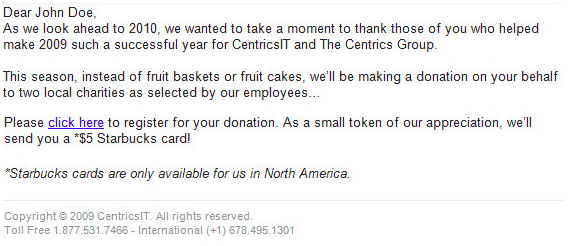
Aforestated unstructured and unfruitful method ended with the introduction of marketing automation in the process. Leads were, thereafter, automatically directed from landing pages to sales reps.
Post implementing a marketing automation tool, the CRM of CentricsIT looked something like this:

As a result, CentricsIT’s lead generation increased by 59%, and $1.5 million in revenue was directly attributed to the implemented marketing automation technology.
What’s good in this case study: CentricsIT moved on from sending blast emails to the right approach of sorting leads and then running more intelligent, automated campaigns for them. Another good thing that the company did was integrating email with website lead tracking.
Therefore, now emails are sent based on users’ web activity. Leads could now be directed directly from landing pages to sales representatives instead of first directed to the inbox marketer.
What could be better: Qualifying leads is something that the sales reps would have to take up. Instead, CentricsIT could identify the potentially most valuable leads with lead scoring in place, thereby making the process even crisper, shorter, and efficient.
(2) Marketing automation example improved lead volume by 200%: SmartBear
Another amazing marketing automation example comes from SmartBear who triggered rapid lead volume using Automation.
SmartBear Software, a B2B cloud mobile software company, was witnessing rapid growth. Processes became difficult to manage manually, and the need for Automation arose.
With Automation in place, the team first starts implementing and testing a few email campaigns.
SmartBear quickly began to implement lead-nurturing to handle a high volume of leads, having learned from challenges and successes. As a result, lead volume grew by 200%. The whole idea to have marketing automation in place was to ensure that there would be a scalable infrastructure to match the expected growth.
You can read the complete case studies on the different challenges and solutions that SmartBear took to implement Automation here.
What’s good about this case study: SmartBear had three product groups at the time, so to nurture the high volume of lead generation, they created nurturing paths for each product group.
What could be better: Along with generating a good volume of leads, SmartBear should also have focused on quality lead management with gated content, progressive profiling, and other capabilities that a smart marketing automation platform offers.
(3) Personalization Increased online registrations by 15%: Brainshark
Third, our list of marketing automation examples to follow is Brainshark.
Brainshark is a B2B software provider that offered a freemium product for its enterprise solution and a free trial for a different product.
Execute Effective Marketing Automation Workflows Now
The challenge was converting their non-paying users into customers. To convert freemium users into paying customers, Brainshark first ran some analysis to understand why ‘freemium’ users would not convert.
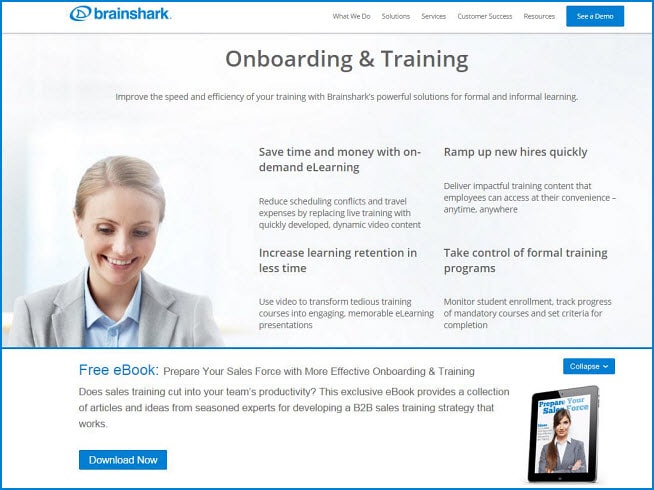
Source: MarketingSherpa
They discovered that:
- Those users who signed up for the free product weren’t always using it
- Users would register but never even start using the product
- Users who registered and uploaded presentations weren’t going further ahead and sharing them
With this analysis at hand, Brainshark knew it had to create ‘pipelines’ to get non-paying customers closer to buying at every step of the pipeline. Marketing automation was the only logical approach to get people to respond to in-trial messages.

Source: MarketingSherpa
They started by showing users messages inside the product interface to guide them through the steps. This communication expanded to ads and pop-ups on their site to communicate with existing users. These messages were educational, such as tips and tricks.
Here’s the entire case for you to read.
What’s good in this case study: From basics, Brainshark moved to ‘personalized’ messaging. Personalization began when a visitor landed on one of the three main areas on the Brainshark website: sales enablement, marketing solutions, or onboarding and training.
All these messages were based on data points such as time on site and pages engaged. Brainshark also intelligently used personalized messaging to upgrade existing users.
What could be better: At the time, Brainshark was running personalized messaging only for ‘logged-in’ users. They were planning to take this a step further by trigger personalized messaging via email also. The who campaign would take a whole new level with personalized drip messaging for communication across all channels.
(4) 200% Increase in conversions with email personalization: The Expert Institute
The Expert Institute’s marketing automation campaigns made our marketing automation examples list because of their sheer brilliance.
The Expert Institute has constantly been growing (not just in size) and in the span and smartness level of its operations. The legal service platform with a model of matching experts in their database with attorneys and investment firms who might need them. With the growing database, The Expert Institute saw and sought opportunities in marketing automation.
They started by running just one email marketing campaign. They worked on imbibing personalization in their campaign by sending out all emails from the vice president of client relations, George Cuchural. They further ensured all of their subscribers’ first names get used in the email.
You can read the whole case study here to find out how the company earned a 60% email open rate, 20% click-through rate, and a 200% increase in conversions by personalization.
For instance, an email sent to the most engaged group, post segmentation of users into less active, moderately engaged, and most engaged groups.
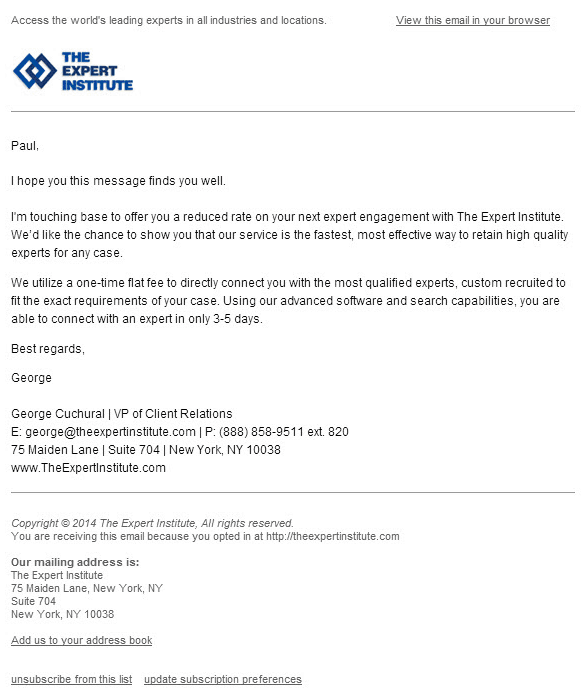
What’s good in this case study: Taking personalization a step further, The Expert Institute bifurcated users based on their engagement levels. And emails sent according to this segmentation. For example, the least engaged people specifically were sent free e-books. And, those who were most engaged received messaging that directly addressed their need for services.
What could be better: Nurturing leads done using multiple channels and not just email. The Expert Institute could have used SMS, push notifications, web notifications, on-site widgets, and social media for the same purpose.
(5) Marketing automation helped in a 175% increase in revenue: Thomson Reuters
Like most big organizations that are rapidly growing, Thomson Reuters also failed to align sales and marketers.
They were also running blast, broadcast campaigns. Segmentation was nowhere in the picture, and leads were sent even without being qualified, from the marketing team to the sales team.
For improving the processes, marketing automation got implemented. With this step taken, leads get first consolidated using a CRM. Thereafter, a lead scoring criterion was backed and got in place. Next, ideal customer profiles got created.
Thanks to automation, these changes resulted in a 23% increase in leads passed to the sales teams and a 175% increase in revenue attributed to marketing-generated leads. It is precisely why Thomson Reuters is here in our marketing automation examples list.
(6) Behavioral segmentation improved open rates by 9%: Mailigen
Mailigen was struggling to get a higher open rate on its email newsletters. To accomplish more and better than the industry average rates, Mailigen implemented behavioral segmentation in email marketing.
To start with behavioral segmentation, the company first selected those subscribers who hadn’t opened the email. The email title copy was then optimized and resented to the list of those who hadn’t opened the email in the first go. They first started by sending out an email to the group that did not open their emails.
They drafted an email on using symbols in emails, and the email looked like this:

Source
However, the open rate was only 20.5% which did not appease Mailigen. They opted to send out the email to the group who did not respond to the first draft, but with a slight change in the headline. Their new draft headline read:
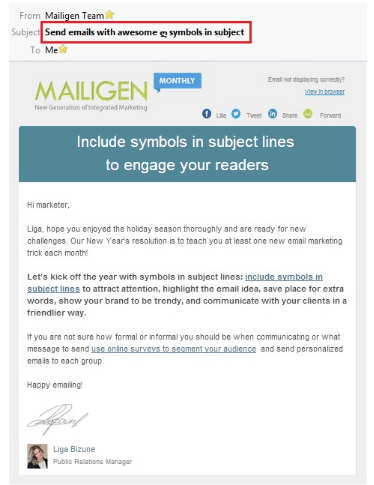
Source
Around 8.6% of subscribers who did not respond to the first email responded now, leading to an open rate of 29.1%. A simple change in the headline and behavioral segmentation helped Mailigen improve their email open rates.
What could be done better: To get more value further and clicks out of the campaign, Mailigen could have run behavioral targeting using web push notifications.
(7) Dell saw a double-digit increase after testing templates: A/B Testing and Automation
The team at Dell wanted to optimize and give their email templates a fresh new look. Another goal of optimizing these landing pages was to improve results on key performance indicators as well.
Getting more specific, they first wanted to determine the impact of making changes to the typical email top navigation that most companies stick with earnestly.
As per their hypothesis, if shifting the traditional top navigation to the email footer could lead to greater hero engagement and improved results.
If you look in the industry, there’s different industry research and case studies. Some support the usage of the header along the top, and others take it out. That was something we hadn’t tried before at Dell. ~ Jessica Vogel, Senior Global Marketing Manager, Dell.
The team decided to split their navigation bars in the emails – The control version had links to various Dell products placed in the header space. It matched the navigation on the Dell website.
The variation had the navigation bar at the footer of the email. In this version, instead of plain links, the team decided to place iconography within the footer.

As a result, they could reduce the noise before the recipient sees the actual message in the email.
We did not want our recipients just to come and browse through our main website. That wasn’t the aim of the emails. We wanted them to see the hero message and take action against it.
With an added focus on creating mobile responsive designs, Dell saw a double-digit win by simply testing their navigation bars in the emails and aligning with their global customers.
What’s good in this case study: They ran an A/B split test to learn and understand these new email templates’ results. And to find out if the new template design helped customers navigate more consistently to the primary call-to-action.
(8) Live chat improved B2B relations for a manufacturing business: Hunter Engineering
Customer support is key to long-term relations. Hunter Engineering, a leading manufacturer, wanted to improve its B2B relations and wisely invest in live chat. By automating on-site chat, this manufacturer wanted to provide on-the-go service for its clients.
Before picking up the phone and calling to reach the service representative, the company realized that many people were going to the website. That’s where the opportunity for automating support came into the picture.
They conducted a webinar with Comm100 to further reveal how Live Chats became their best option in steering customer conversations and improving their B2B relations.
The key improvements Hunter Engineering made with live chat were:
- Smooth and immediate interaction with leads or customers
- Reduced sales cycle
(9) Five9 increased conversion rates by 300% with an ebook effort
Five9 is a call center software that wanted to align their content and funnel their prospects onto their sales teams. To achieve this goal, they ran a complete campaign using marketing automation.
They started by creating customer avatars by interviewing their current customers. Next, they created an eBook using the feedback from the interview/survey.
Additionally, they used sections from this eBook to be repurposed and republished on different social media marketing platforms and blog posts. They even used repurposed content for lead nurturing.

The eBook was designed by dividing it into 9 sections, which got recreated as blog posts and social media posts. Pat Oldenburg, Senior Manager of Content Marketing, said
We had a whole social plan. We had a blog plan, where we had 10 blog posts total and several social posts for each of those. We also turned it into a nurture campaign. This included:
- 11 blog posts
- 33 social posts
- 2 e-book download
- 9 assets in the nurture campaign (9 guides with 9 landing pages and emails
- 6 emails
Read their complete success story here.
(10) Automated Email Drips can convert non-paying customers: Box
Box, a software company, wanted to run an onboarding campaign to convert more trial users into paying customers.
To do so, the company created what they call “Box Tips.” These were a series of email-based content based on key product features.
Creating such educational content and serving it at relevant time periods makes sure that the user keeps moving closer to completing all steps, one-by-one, till he becomes a billable user.
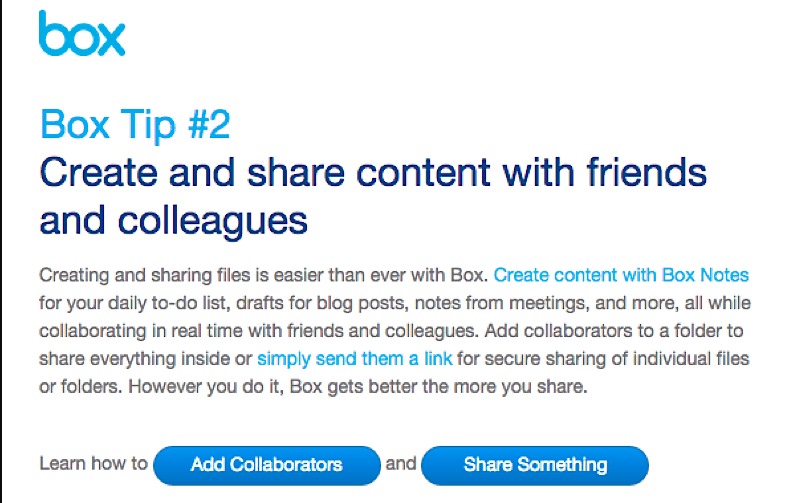
What could be improved: Probably instead of focusing only on one channel, email, companies like Box can run drip campaigns on multiple channels.
(11) Optimizing forms can increase conversions
A basic and now notable finding is that forms that require you to fill out all fields will increase bounce-offs. On the other hand, forms that don’t require you to fill all fields will have a higher registration rate.
Sometimes, the shorter the form, the better. And even the automated form filling option saves users the time and effort of registration. These are some of the form optimization case studies that show which version won.
In one of the three case studies that we’ve linked to, the question asked at hand was whether you should ask users to fill out all form fields. The result, however, proved that you don’t really need prospects to fill out all fields to get all data about them.
Additionally, reshaping your forms into more interactive experiences such as a calculator, assessment, or quiz can get you 2x more conversions than static forms. You still collect the data you need and lower the threshold by offering useful, personalized information in return.
By analyzing how your visitors answered the questions in the quiz, you might even discover additional insights about their preferences that can help you in the nurturing process. There are lots of assessment tools out there that could help you achieve this.
Build a successful B2B marketing automation workflow
All these marketing automation examples allude to just one thing – you need to build your marketing automation workflow right. In the above marketing automation examples, each brand used marketing automation to break down the blocks that were keeping the leads from becoming customers. But you can make your marketing automation strategy pitch-perfect by implementing an advanced automation suite.
Try Aritic PinPoint not because I am saying but because this tool is comprehensive, fully integrated, and is user-friendly. Here are what’s more:
- Easy onboarding and user-friendly UI.
- Advanced lead management features including lead source analysis, anonymous lead nurturing, 360-degree lead profiling, predictive lead scoring, and lead tracking
- Progressive profiling for better lead capturing
- Multichannel marketing – emails, landing pages, push campaigns, SMS campaigns, mobile marketing, social media marketing, and web.
- Multichannel drip automation campaigns
- Automated workflows
- Detailed analytics and A/B testing
- Ready to use and responsive landing page templates, email templates, social templates.
- Advanced social media marketing with social bots
- Deals and Pipeline features for sales team exclusively
- Improves team productivity and aligns marketing-sales.
- Account-based marketing for enterprise clients; and more.
Take a full tour of Aritic PinPoint to decide for yourself or straightaway sign up with a free account to build your ideal marketing automation strategy now.
⭐ What is the difference between B2B marketing and B2C marketing?
B2C marketing is more focused on having direct relationships with your clients and reaching out to them through various channels such as print, digital, or television advertisements, social media. While B2B marketing involves businesses selling products and services directly to other businesses. The goal of B2B marketing is to build long-term relationships with strategic partners, not just one-time sales.
⭐ How do you automate B2B sales?
You can’t afford to wait for your sales team to reach out to every lead in their queue. That’s why it’s so important to create automated strategies that help you prospect, build relationships with, and convert new customers.
⭐ What is sales funnel automation?
Sales funnel automation is at the heart of any marketing automation software. It’s how you turn your website into a visitor-to-customer conversion machine. Sure, your company needs to create great content and promote it on all social media channels, but that won’t have much effect if you can’t get enough traffic to it in the first place. That’s where sales funnel automation comes in! You can boost your sales process by streamlining your entire sales funnel within Aritic Sales.
⭐ What are B2B marketing strategies?
B2B marketing strategies are predominantly aimed at businesses who want to increase their sales by selling to other businesses. B2B Marketing automation is flourishing at an exponential rate and would only pick pace in the future. New B2B marketing automation strategies and trends are one thing you must keep up with as a marketer.
⭐ What should be in a B2B marketing plan?
An effective B2B marketing plan is a concise document that helps your company strategize how it will reach its target audience. A successful marketing strategy not only grows the customer base but also fosters brand loyalty.
⭐ How do you target B2B?
There are a number of ways in which you can target business-to-business (B2B) marketing. When it comes to targeting a specific market is finding a way to refine your message into one that resonates with the audience you want to reach.
⭐ Do B2B companies need social media?
Many businesses still wonder if social media is the right fit for their brand. It’s no doubt that social media has changed the way we live our lives, but does it play a role in business-to-business (B2B) marketing? The answer is an overwhelming yes!
⭐ Which social media is best for B2B?
While social media platforms keep changing, the best ones for B2B marketing have been around for a while. Social media is a great opportunity to engage with your customers and show that you understand their needs in a way no one else does. But what is the best platform to use? The answer lies in which audience you prefer to reach out to, and how much time you have for this process.



3 Comments
I like your post. I like it. For over 25 years David Soble has provided no nonsense legal advice to banks, lenders and consumers alike, in the areas of commercial and residential real estate, business and residential lending and contract matters.
Bravo! An in-depth and detailed article. These are some examples for those who want to follow the best marketing automation solution.
Bravo! A thorough and detailed article. These are exactly some perfect examples I was looking for as I follow the best practices on marketing automation.